Birdfinding.info ⇒ The southern form of Heuglin’s Gull is locally common on its remote central Asian breeding grounds. From late August to late March, it is readily found at many coastal sites around the Persian Gulf, Oman, and western India, where it is often the predominant large gull.
“Steppe Gull”
Larus heuglini barabensis
Breeds on the central Asian steppes; winters along Indian Ocean coasts of southwestern Asia.
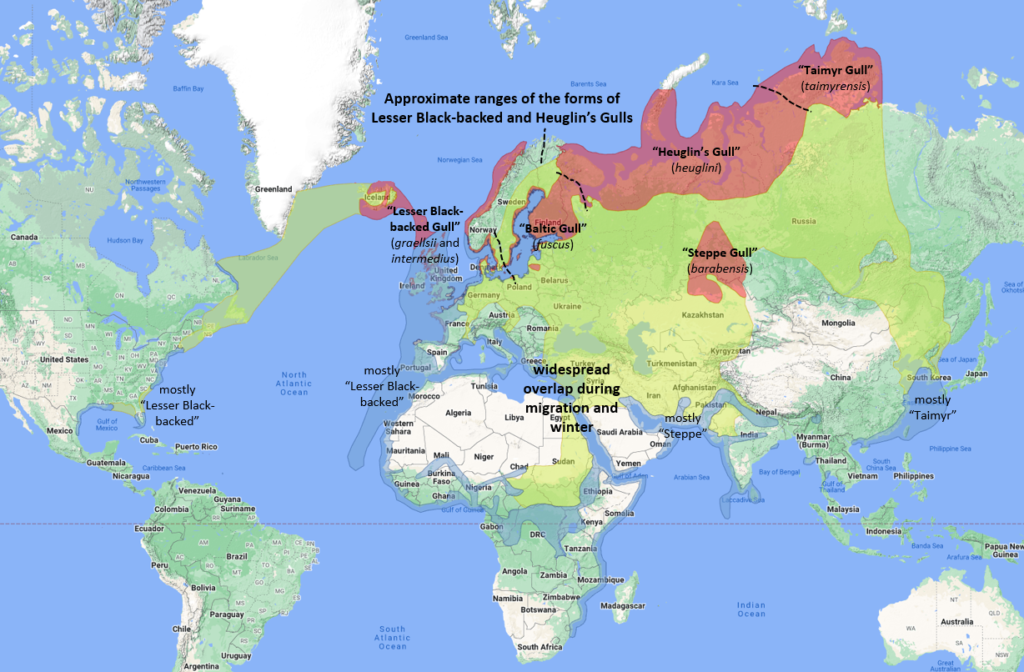
Approximate ranges of the forms classified within Lesser Black-backed and Heuglin’s Gulls. © Xeno-Canto 2022
Breeding. Nests on islands in lakes and rivers on the steppes of southwestern Siberia, northern Kazakhstan, and adjacent parts of southeastern Russia. Adults arrive on the breeding grounds in late March, and nest in April. Chicks hatch in June, and the southbound migration occurs mainly during August.
The main breeding areas are east of the Ural Mountains, but small numbers breed locally west of the Urals, at least occasionally as far west as Kirov and Tatarstan, where it may be expanding its breeding range.
Nonbreeding. Winters mainly along coasts from the Persian Gulf and eastern Arabian Peninsula east to southwestern India. Smaller numbers winter along coasts of the Red Sea and eastern Mediterranean, south to Eritrea and Socotra, and east to Thailand.
The full extent of the “Steppe Gull’s” winter distribution is incompletely understood due to difficulties in identification. Gulls that appear most similar to “Steppes” have been found annually wintering in South Korea, but its status there apparently remains unconfirmed.
Identification
A confusingly intermediate gull that resembles several other members of the Lesser Black-backed and Herring Gull complexes. Some authorities have suggested that it originated from hybridization of Heuglin’s (heuglini) with Caspian (cachinnans) Gulls. “Steppe” is nearly identical to the nominate heuglini, but with a paler mantle, and to the Armenian Gull (armenicus), but with structural differences.

“Steppe Gull”, L. h. barabensis, in typical breeding plumage. (Ordynskiy Rayon, Novosibirsk, Russia; April 8, 2018.) © andreenkov
Adult Plumages. Adults have a medium-gray mantle that is distinctly paler than other Lesser Black-backed or Heuglin’s forms and usually somewhat darker than any of the Herring-type gulls.
“Steppe’s” wingtips are extensively black, usually with a white “mirror” near the tip of the outermost primary and a much smaller one on the next primary. The black on “Steppe’s” wingtips typically forms a neat triangle on the spread wing, with two narrow gray tongues.
The legs are yellow, vivid when breeding, often dull-yellow at other seasons.
The bill is about average length and thickness among gulls of its size. In addition to a red spot, it often shows distinct black marks near the tip. These markings are usually weak or absent in peak breeding plumage, but are often noticeable at other seasons.

“Steppe Gull”, L. h. barabensis, in breeding plumage, showing typical coloration and wingtip pattern. (Ordynskiy Rayon, Novosibirsk, Russia; April 8, 2018.) © andreenkov

“Steppe Gull”, L. h. barabensis, a notably pale-mantled individual in breeding plumage. (Burlinskiy Rayon, Altay, Russia; July 14, 2021.) © vladimir_maer
Adult “Steppes” in winter typically show little if any dark streaking on the head or neck—usually limited to a few fine streaks on the nape. As a result, the nonbreeding plumage does not differ noticeably from breeding plumage.

“Steppe Gull”, L. h. barabensis, a notably dark-mantled individual in breeding plumage. (Lake Tengiz, Aqmola, Kazakhstan; June 11, 2006.) © Nigel Voaden
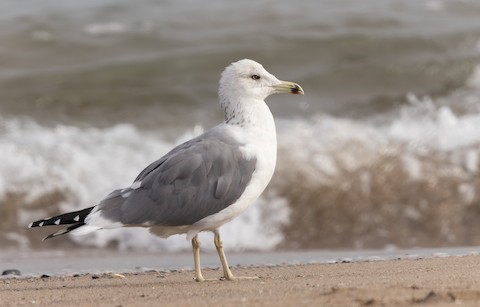
“Steppe Gull”, L. h. barabensis, third-winter, showing black ring near the tip of the bill and fine streaks on the nape. (Al Mouj, Mascat, Oman; November 3, 2021.) © Lars Petersson
Immature Plumages. As in other Lesser Black-backed and Herring-type Gulls, juvenile “Steppes” are brown with bold spots on the mantle and wing coverts. The bold spots wear off between September and November, leaving the upperparts pale-brown or whitish-gray overall, with narrow chevrons and anchors on most first-winter and first-summer birds.

“Steppe Gull”, L. h. barabensis, juvenile. (Khor Kalba, Sharjah, U.A.E.; August 17, 2010.) © Tommy Pederson

“Steppe Gull”, L. h. barabensis, juvenile. (Saadiyat Beach Golf Club, Abu Dhabi, U.A.E.; October 13, 2020.) © Nikos Mavris
On the spread wing, first-year “Steppes” show blackish primaries, primary coverts, and secondaries. The inner primaries often appear somewhat paler than the other flight feathers, but this “window” effect is less pronounced than on Herring-type gulls. The coverts often show alternating pale and dark bars running the length of the wing.
The tail feathers are mostly black, whereas the rump, uppertail coverts, and the bases of the outer tail feathers are mostly pale with sparse barring—rapidly transitioning to white with little or no barring.
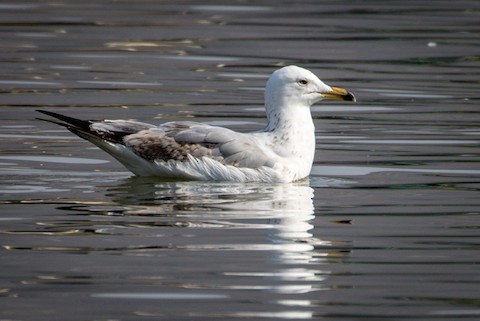
“Steppe Gull”, L. h. barabensis, second-winter. (Lake Man Sagar, Jaipur, Rajasthan, India; February 12, 2019.) © Michael Warner
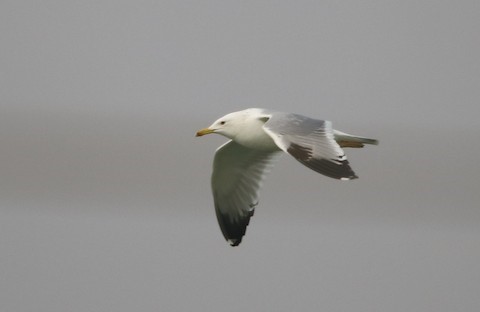
“Steppe Gull”, L. h. barabensis, likely third-winter. (Ameenpur Lake, Hyderabad, Sangareddy, Telangana, India; December 9, 2018.) © Bhaarat Vyas
Subadult Plumages. By the second winter, most subadults closely resemble adults, but usually with black remaining in the tail, more extensive black on the primaries and primary coverts, and a pronounced black ring near the tip of the bill.
Notes
Monotypic form, of unsettled status, but the apparently growing consensus is to classify it as one of three distinct forms of Heuglin’s Gull (heuglini). It has been alternatively classified as a form of the Caspian Gull (cachinnans), and more closely resembles the Armenian Gull (armenicus).
The status of Heuglin’s Gull as a species or subspecies group also remains unsettled, as it has traditionally been considered conspecific with the Lesser Black-backed Gull (fuscus).
See below for comparisons of the “Steppe Gull” with “Taimyr”, “Heuglin’s”, Armenian, and Caspian Gulls.
Cf. “Taimyr Gull”. “Taimyr” and “Steppe” Gulls are both widely suspected of having descended from Heuglin’s Gull through a history of hybridization with other populations—Vega (vegae) and Caspian (cachinnans) Gulls, respectively. Both are difficult to identify with confidence outside of the core areas where each is known to occur regularly. In general, “Taimyr” breeds in the high arctic and winters along Pacific coasts of East Asia, whereas “Steppe” breeds in central Asia and winters along Indian Ocean coasts of southwestern Asia. They are not known to overlap, but both have sometimes been suspected of occurring on the other’s wintering grounds, and records from Southeast Asia and Europe are difficult to evaluate without a geography-based presumption.
Identification criteria for both “Taimyr” and “Steppe” remain imperfectly understood, but a few factors appear to be clear enough to be useful in resolving some ambiguous cases.
Nonbreeding Adult Bill Pattern: In winter, adult “Steppe” typically develops a partial black ring near the tip. This seems to be unknown in “Taimyr”, so its presence may be diagnostic of “Steppe”.
Nonbreeding Adult Head Pattern: In winter, adult “Taimyrs” typically develop dark streaks on the head and neck, mostly on the nape, but often a full necklace and sometimes on the head as well. “Steppe” rarely develops substantial streaking—perhaps only in subadults or in the transition to definitive adult plumage (i.e., third- and fourth-winter plumages), and it is typically limited to fine streaks on the nape.
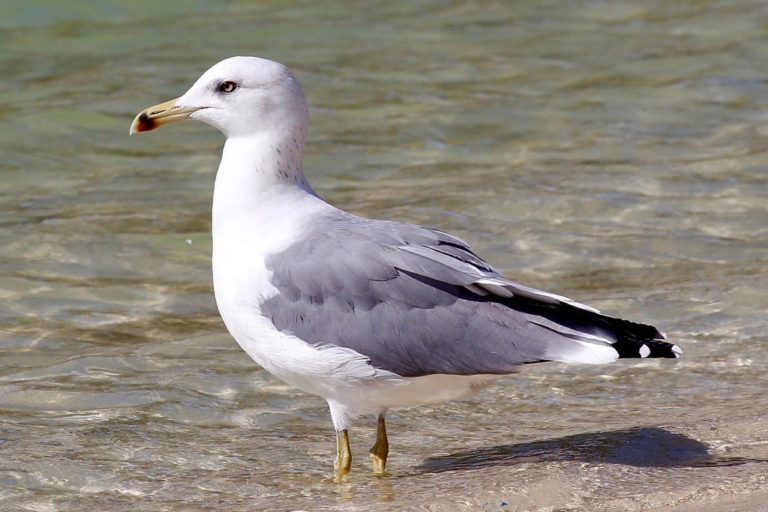
“Steppe Gull”, L. h. barabensis, in nonbreeding plumage, showing black ring near the tip of the bill and fine streaks on the nape. (Abu Dhabi, U.A.E.; November 14, 2019.) © Bird Explorers
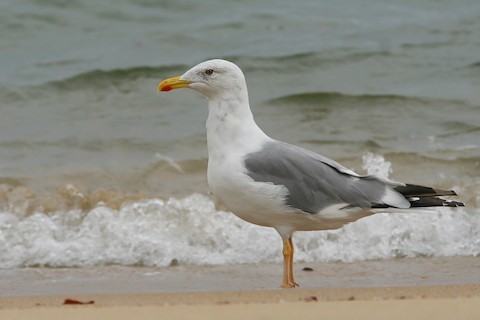
“Taimyr Gull”, L. h. taimyrensis—a notably pale-mantled individual identified by the observer as taimyrensis, early in the transition into nonbreeding plumage, with streaks beginning to appear on the head and no black on the bill. (Beppu, Oita, Kyushu, Japan; November 1, 2009.) © Ayuwat Jearwattanakanok
Wingtip Pattern: Although their wingtips probably do not differ consistently enough for reliable identification, one fairly consistent difference is the extent of their white “mirrors.” “Taimyr” typically has a single white mirror near the tip of the outermost primary (P10), whereas “Steppe” usually has the P10 mirror plus a smaller white spot adjacent to it on the next primary (P9).
Adult Mantle Color: On average, “Taimyr” tends to appear darker-gray than “Steppe”; however, both vary enough internally that the overlap between them might effectively overwhelm the difference.
Adult Leg Color: “Steppe” has yellow legs. “Taimyr’s” legs are usually yellow, but sometimes orangish and reportedly pink in some cases.
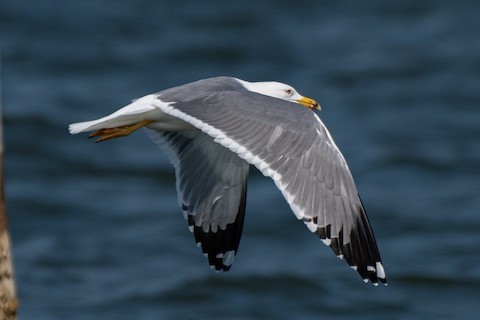
“Steppe Gull”, L. h. barabensis—judging from the black markings on the bill, and supported by the small white mirror spot on P9 and the lack of streaking on the head and neck. (Chao Phraya Shipping Channel, Samut Prakan, Thailand; January 26, 2022.) © Andaman Kaosung
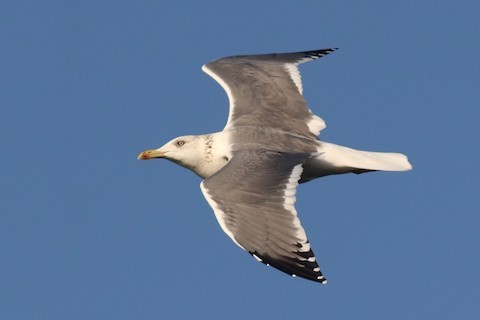
“Taimyr Gull”, L. h. taimyrensis, in nonbreeding plumage, showing heavy streaking on the nape and smudges on the head, lacking distinct black near the tip of the bill. (Aogu Wetlands and Forest Park, Dongshi, Chiayi, Taiwan; January 10, 2022.) Anonymous
Molt-Stage: “Steppe” arrives on its breeding grounds in late March and nests in April, whereas “Taimyr” arrives on its breeding grounds in late May and nests in June. The timing of their molts and the stages of seasonal feather-wear are therefore likely to differ by an average of about two months.
Cf. “Heuglin’s Gull”. In recent decades, most gull experts have provisionally regarded “Steppe” (barabensis) and “Heuglin’s” (heuglini) as distinct forms within a single species, either Heuglin’s Gull or merged into the Lesser Black-backed Gull. They overlap widely, as “Heuglin’s” regularly occurs in migration or winter throughout “Steppe’s” range—“Steppe” has a much smaller range and predominates within it.
Adult Mantle Color: Adult “Steppe” and “Heuglin’s” share most features in common except that “Heuglin’s” has a noticeably darker mantle. When they occur together, which they often do, the difference is usually distinct and sufficient to identify them.
Apart from mantle-color, other differences observed between them appear to be slight, inconsistent, or questionable.
Nonbreeding Adult Head Pattern: In winter, adult “Heuglin’s” typically develops a hood of dark streaks on the head and neck. The full extent of the streaking varies widely. It is almost always most pronounced on the nape, but usually extends around the neck and onto the head. “Steppe” rarely develops substantial streaking—perhaps only in subadults or in the transition to definitive adult plumage (i.e., third- and fourth-winter plumages), and it is typically limited to fine streaks on the nape.
Molt-Stage: “Heuglin’s” breeds on arctic tundra, whereas “Steppe” breeds at temperate latitudes approximately two months earlier, so “Heuglin’s” typically molts later than “Steppe”, which may be helpful to the identification of some individuals.
Cf. Caspian Gull. Caspian and “Steppe” Gulls overlap widely across central and southwestern Asia, and are similar enough that they have often been regarded as conspecific—in fact, the “Steppe Gull” may have originated in part from hybridization of Caspian and “Heuglin’s” Gulls. Both Caspian and “Steppe” have medium-gray mantles, tend to have dark eyes, and often show a partial black ring near the tip of the bill.
Most of the visual differences between them are subtle, and may be inconsistent. Caspian’s mantle usually appears paler-gray and its wingtips usually have much less extensive black than on “Steppe”. When viewed in flight, “Steppe’s” black wingtips typically appear to encompass the three outer primaries almost entirely, and a substantial portion of the next three, with a white dot or sliver at the extreme tip of each. The amount of black in Caspian’s wingtips varies widely, but usually covers less of each feather: with gray tongues on the outer primaries and larger white spots at the tips. Many individual Caspians have remarkably large white mirrors at the outermost tips.
The Caspian Gull differs subtly from other large gulls in having a proportionately long bill and thin head. In posture, it often appears lanky, extending its neck to hold its head high. Caspian’s bill tends to appear paler, more greenish or grayish-yellow overall than other species—but is more typically vivid-yellow when breeding. Its leg color often matches the bill, but is more variable: gray or pink in most immatures and some adults. Juvenile and other first-year Caspian Gulls tend to have whiter heads and bellies than most other large gulls.
Cf. Armenian Gull. Armenian and “Steppe” Gulls are extremely similar and sometimes occur together in winter and migration—as small numbers of each apparently wander into one another’s usual ranges. Both have yellow legs, often have dark eyes, and often show a partial black ring near the tip of the bill. Both have medium-gray mantles, and their adult wingtip patterns do not appear to differ consistently.
The most consistent observable difference between Armenian and “Steppe” Gulls is bill shape. Armenian’s bill is generally shorter and thicker than the bills of other large gulls, whereas the “Steppe Gull’s” bill averages slightly longer and thinner than most. With a clear image of the bill in profile, most individuals should be identifiable as one or the other.
Other differences are more subtle and less consistent, but may be useful in some cases. Armenian’s mantle usually appears paler-gray—enough to be noticeable in side-by-side comparison. Armenian’s head tends to appear more rounded than other large gulls, whereas “Steppe’s” head often appears somewhat flattened. Based on many available photos, Armenian’s legs tend to be a richer shade of yellow, more orange, than “Steppe’s”.
More Images of the “Steppe Gull”

“Steppe Gull”, L. h. barabensis, in breeding plumage. (Egor’evskiy Rayon, Altay, Russia; April 8, 2022.) © vladimir_maer

“Steppe Gull”, L. h. barabensis, nonbreeding adult and first-winter. (Al Sawadi, Al Batinah, Oman; January 24, 2016.) © Luis Mario Arce
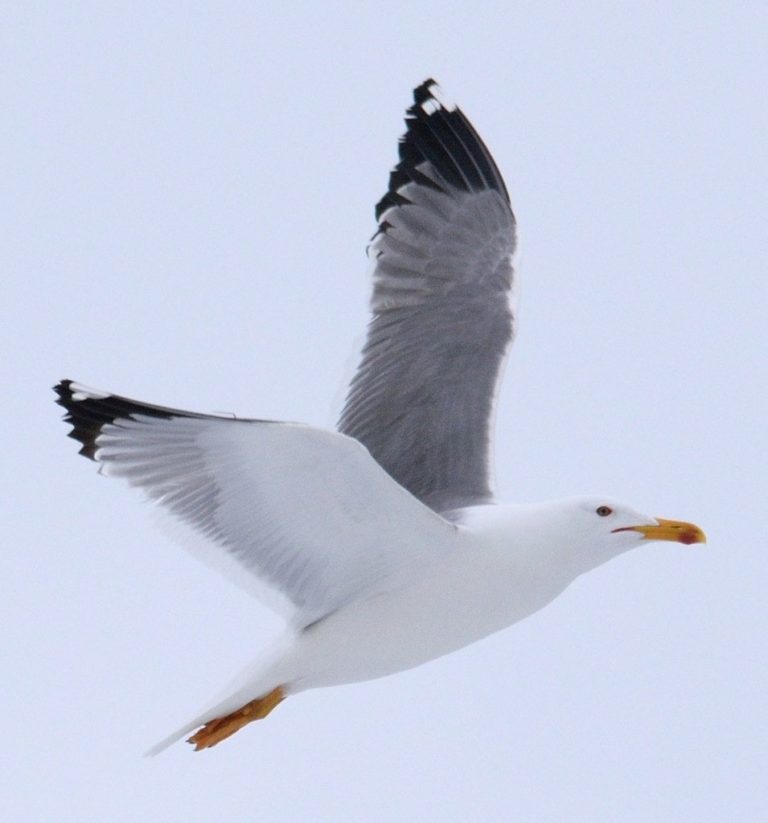
“Steppe Gull”, L. h. barabensis. (Ordynskiy Rayon, Novosibirsk, Russia; April 8, 2018.) © andreenkov
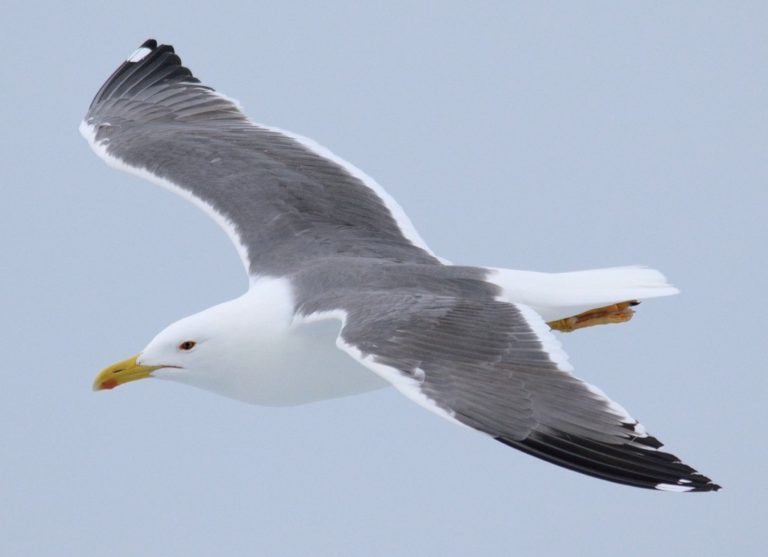
“Steppe Gull”, L. h. barabensis. (Ordynskiy Rayon, Novosibirsk, Russia; April 8, 2018.) © andreenkov
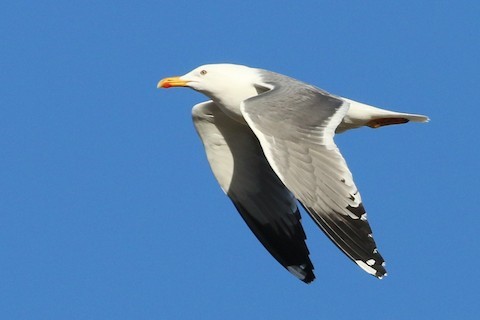
“Steppe Gull”, L. h. barabensis. (Ras Shukeir Sewage Works, Al Bahr al Ahmar, Egypt; March 13, 2017.) © Alexandre Hespanhol Leitão

“Steppe Gull”, L. h. barabensis. (Ordynskiy Rayon, Novosibirsk, Russia; June 7, 2015.) © andreenkov

“Steppe Gull”, L. h. barabensis, first-winter. (Lake Man Sagar, Jaipur, Rajasthan, India; February 12, 2019.) © Michael Warner
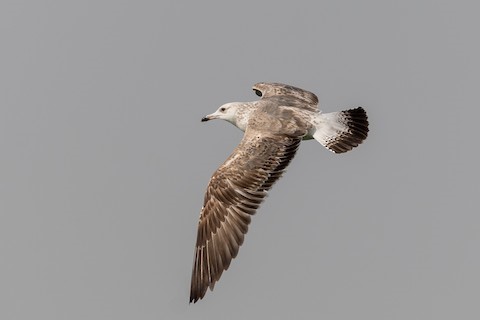
“Steppe Gull”, L. h. barabensis, first-winter. (Community Garden Park, Abu Dhabi, U.A.E.; March 10, 2022.) © Nikos Mavris
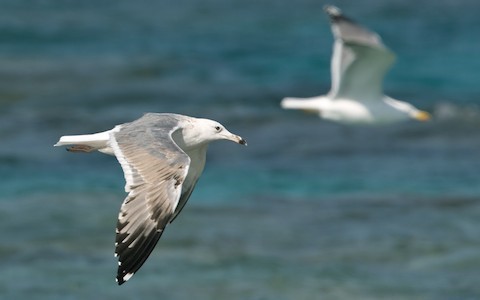
“Steppe Gull”, L. h. barabensis, second-winter. (Aqaba, Jordan; March 7, 2019.) © Lars Petersson
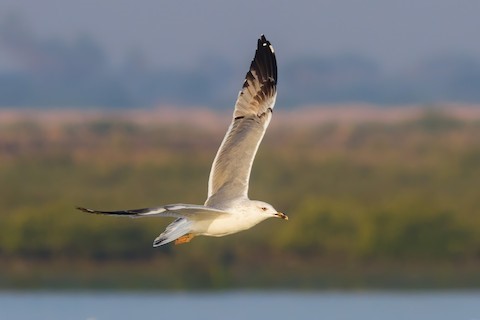
“Steppe Gull”, L. h. barabensis, second- or third-winter. (Vanakvara, Gir Somnath, Gujarat, India; December 16, 2013.) © Yeray Seminario
References
Babbington, J. 2013. Large Gull ID Help. Birds of Saudi Arabia. https://www.birdsofsaudiarabia.com/p/large-gull-id.html. (Accessed April 20, 2022.)
eBird. 2022. eBird: An online database of bird distribution and abundance. Cornell Lab of Ornithology, Ithaca, N.Y. http://www.ebird.org. (Accessed April 20, 2022.)
Moores, N. 2005. Steppe Gull barabensis in South Korea: A Step Closer To Identification? http://www.birdskorea.org/Birds/Identification/ID_Notes/BK-ID-Steppe-Gull.shtml.
Moores, N. 2011. Taimyr Gull Larus (heuglini) taimyrensis: an Update. BirdsKorea. http://www.birdskorea.org/Birds/Identification/ID_Notes/BK-ID-Taimyr-Gull.shtml.
Olsen, K.M., and H. Larsson. 2003. Gulls of North America, Europe, and Asia. Princeton University Press.
Porter, R.F., S. Christensen, and P. Schiermacker-Hansen. 1996. Field Guide to the Birds of the Middle East. T & A D Poyser, London.
Redman, R., T. Stevenson, T., and J. Fanshawe. 2009. Birds of the Horn of Africa: Ethiopia, Eritrea, Djibouti, Somalia, and Socotra. Princeton University Press.
Sinclair, I., and P. Ryan. 2003. Birds of Africa South of the Sahara. Princeton University Press.
Svensson, L., K. Mullarney, and D. Zetterström. 2009. Birds of Europe (Second Edition). Princeton University Press.
Xeno-Canto. 2022. Lesser Black-backed Gull – Larus fuscus, https://xeno-canto.org/species/Larus-fuscus. (Accessed April 18, 2022.)
